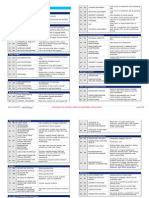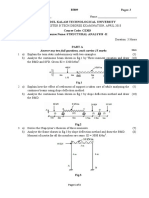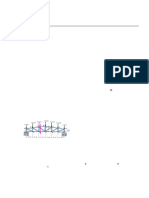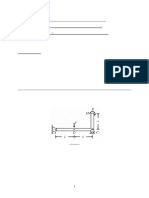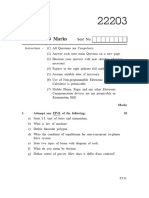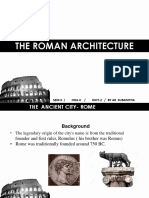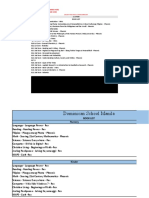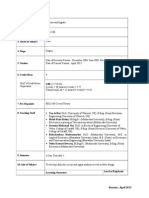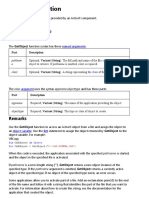18 Eng 151
18 Eng 151
Uploaded by
katti1084154Copyright:
Available Formats
18 Eng 151
18 Eng 151
Uploaded by
katti1084154Original Description:
Original Title
Copyright
Available Formats
Share this document
Did you find this document useful?
Is this content inappropriate?
Copyright:
Available Formats
18 Eng 151
18 Eng 151
Uploaded by
katti1084154Copyright:
Available Formats
www.android.universityupdates.in | www.universityupdates.in | www.ios.universityupdates.
in
MODEL QUESTION PAPER (CBCS 2018 SCHEME) (For Reference only)
Note: The model question paper highlights the overall distribution of marks and provides generic
examples of questions set with reference to the modules & syllabus.
USN 18ENG15
VISVESVARAYA TECHNOLOGICAL UNIVERSITY
I Semester B.Arch. (CBCS 2018 Scheme) Examination ……… 2018
BUILDING STRUCTURES-I
Time: 03 Hours Maximum Marks: 100
Instructions for Candidates
1) All questions carry equal marks.
2) Answer FIVE Full questions, taking ONE question from each Module.
3) Follow written dimensions do not scale the drawing.
1.
Module 1
a) Write important properties of Steel, Wood, Aluminium and Concrete.
te s 12
a
b) Explain with example Static load & Dynamic load. 08
OR
p
2. a) What are the different types of tests conducted on Fresh and hardened d 08
concrete.
U
b) Explain the factors affecting the durability of concrete.
y
08
t
c) Write a note on Thermo mechanically treated(TMT) steel 04
r
3. (a) Differentiate between
s i Module 2
09
i e
(i) Rigid body & Deformable body
v
(ii) Concurrent force system & Parallel force system
(iii) Resolution of force & Composition of force
U n
(b) Mention any 3 axioms of mechanics.
(c) Determine the magnitude & direction of force 'F' such that resultant force
270N acts Y axis as shown in fig. 3c
03
08
Fig. 3c
1
www.android.universityupdates.in | www.universityupdates.in | www.ios.universityupdates.in
www.android.universityupdates.in | www.universityupdates.in | www.ios.universityupdates.in
MODEL QUESTION PAPER (CBCS 2018 SCHEME) (For Reference only)
Note: The model question paper highlights the overall distribution of marks and provides generic
examples of questions set with reference to the modules & syllabus.
USN 18ENG15
OR
4. (a) Explain the geometrical representation of moment of force about a point. 04
(b) A Rigid bar AB is subjected to a system of parallel force, reduce the system 06
to an equivalent (Refer fig. 4b)
(i) Single Resultant
(ii)Force - Moment system at A
(iii)find equilibrant of the system
te s
d a
U p
i t y
s
Fig. 4b
e r
(c) Determine the magnitude & direction of resultant force for coplanar 10
v
concurrent forces shown in fig. 4c
n i
U
Fig. 4c
www.android.universityupdates.in | www.universityupdates.in | www.ios.universityupdates.in
www.android.universityupdates.in | www.universityupdates.in | www.ios.universityupdates.in
MODEL QUESTION PAPER (CBCS 2018 SCHEME) (For Reference only)
Note: The model question paper highlights the overall distribution of marks and provides generic
examples of questions set with reference to the modules & syllabus.
USN 18ENG15
Module 3
5. (a) Find the resultant of the force system acting on the lamina of equilateral 10
triangular shape (Refer fig. 5a)
te s
d a
Fig. 5a
U p
completely (Refer 5b)
i t y
(b) Bracket is subjected to three forces & couple Determine the Resultant force 10
e r s
n i v
U
Fig 5b
www.android.universityupdates.in | www.universityupdates.in | www.ios.universityupdates.in
www.android.universityupdates.in | www.universityupdates.in | www.ios.universityupdates.in
MODEL QUESTION PAPER (CBCS 2018 SCHEME) (For Reference only)
Note: The model question paper highlights the overall distribution of marks and provides generic
examples of questions set with reference to the modules & syllabus.
USN 18ENG15
OR
6. Explain briefly:
(a) What are statically determinate & statically indeterminate beams with 08
examples
(b) Determine the support reactions for the beam shown is Fig. 6b 12
te s
d a
U p
i t y Fig. 6b
e r s Module 4
n i v
7. (a) Locate the centriod of the Tee section shown fig. 7a 08
U
Fig. 7a
www.android.universityupdates.in | www.universityupdates.in | www.ios.universityupdates.in
www.android.universityupdates.in | www.universityupdates.in | www.ios.universityupdates.in
MODEL QUESTION PAPER (CBCS 2018 SCHEME) (For Reference only)
Note: The model question paper highlights the overall distribution of marks and provides generic
examples of questions set with reference to the modules & syllabus.
USN 18ENG15
(b) Locate the centriod of the composite section shown fig. 7b 12
te s
d a
Fig.7b
U p
i t y OR
e r s
8. Compute the moment of inertia of the section shown in about its centriodal 08
n i v
axis, also find polar moment of inertia. Fig. 8
Fig.8
www.android.universityupdates.in | www.universityupdates.in | www.ios.universityupdates.in
www.android.universityupdates.in | www.universityupdates.in | www.ios.universityupdates.in
MODEL QUESTION PAPER (CBCS 2018 SCHEME) (For Reference only)
Note: The model question paper highlights the overall distribution of marks and provides generic
examples of questions set with reference to the modules & syllabus.
USN 18ENG15
Module 5
9. (a) What are the assumptions made in the analysis of truss. 05
(b) Determine the support reactions for the truss shown in Fig. 9b. 06
te s
d a
U p
i t yFig. 9b
"Method of Joints".
e r s
(c) Determine the force in each member for truss shown in Fig. 9b by
OR
09
n i v
10. Determine the force in each member by method of joints, mention the nature of
force in each for the truss shown in fig. 10.
20
Fig. 10
www.android.universityupdates.in | www.universityupdates.in | www.ios.universityupdates.in
You might also like
- En. Zoom Meeting With Medical Doctors For Covid Ethics International - 20 Nov 2022Document5 pagesEn. Zoom Meeting With Medical Doctors For Covid Ethics International - 20 Nov 2022Jim Hoft100% (5)
- IATA Delay CodesDocument2 pagesIATA Delay Codestest1616262100% (6)
- Design of AbsorberDocument18 pagesDesign of AbsorberAdeel Ahmed100% (2)
- 18eng152 PDFDocument4 pages18eng152 PDFkatti1084154No ratings yet
- Computational Mechanics_2024_19 BatchDocument5 pagesComputational Mechanics_2024_19 BatchrashtharinNo ratings yet
- ECT-3354-ANALYSIS-OF-STRUCTUREs Quiz 1Document3 pagesECT-3354-ANALYSIS-OF-STRUCTUREs Quiz 1Levis MithamoNo ratings yet
- 21ENG26 JAN-FEB 2023 Building Structures - IDocument3 pages21ENG26 JAN-FEB 2023 Building Structures - IRupakNo ratings yet
- Answer Any Two Full Questions, Each Carries 15 Marks Answer Any Two Full Questions, Each Carries 15 MarksDocument3 pagesAnswer Any Two Full Questions, Each Carries 15 Marks Answer Any Two Full Questions, Each Carries 15 MarksSRUTHI PNo ratings yet
- 2018 April CE303-C - Ktu QbankDocument3 pages2018 April CE303-C - Ktu QbankYasmine SahilNo ratings yet
- Answer Any Two Full Questions, Each Carries 15 Marks.: Reg No.: - NameDocument3 pagesAnswer Any Two Full Questions, Each Carries 15 Marks.: Reg No.: - NameirshadNo ratings yet
- Structural StabilityDocument2 pagesStructural StabilityTibu ChackoNo ratings yet
- ECT362-QP May 2023Document3 pagesECT362-QP May 2023rijovskNo ratings yet
- Computational Structural EngineeringDocument26 pagesComputational Structural EngineeringVarun. hrNo ratings yet
- 203115204_4426_Question_PaperDocument2 pages203115204_4426_Question_Paper9723071661zNo ratings yet
- FINAL EXAM BAA 1113 Sem II 1718Document6 pagesFINAL EXAM BAA 1113 Sem II 1718naaaNo ratings yet
- P.E.S. College of Engineering, Mandya - 571 401Document2 pagesP.E.S. College of Engineering, Mandya - 571 401Vikas D NayakNo ratings yet
- 21 CIV14 Set 2Document9 pages21 CIV14 Set 2elizadiscord2503No ratings yet
- B G1032 Pages: 3: Answer Any Two Full Questions, Each Carries 15 MarksDocument3 pagesB G1032 Pages: 3: Answer Any Two Full Questions, Each Carries 15 MarksirshadNo ratings yet
- Ect 3354 Analysis of Structures IvDocument4 pagesEct 3354 Analysis of Structures IvLevis MithamoNo ratings yet
- Gujarat Technological UniversityDocument2 pagesGujarat Technological Universitydikuptl67No ratings yet
- MA3002 2022-2023 Semester 1Document5 pagesMA3002 2022-2023 Semester 1kong99942No ratings yet
- Gujarat Technological UniversityDocument3 pagesGujarat Technological Universitysamirzala012003No ratings yet
- Soalan Final Analisis Struktur UTHMDocument13 pagesSoalan Final Analisis Struktur UTHMliyana2030No ratings yet
- USN X, E/ Y: Experim N MechaDocument2 pagesUSN X, E/ Y: Experim N Mechamusic lover oldNo ratings yet
- Gujarat Technological UniversityDocument3 pagesGujarat Technological UniversityDeep PatelNo ratings yet
- Ecv 204 Theory of Structures IDocument3 pagesEcv 204 Theory of Structures Ijebichiimichelle7731No ratings yet
- Me62o June2021Document3 pagesMe62o June2021Rambo 420No ratings yet
- CE506Document4 pagesCE506Mr RAJESWARAN PNo ratings yet
- TEB 211_ THEORY OF STRUCTURES IDocument4 pagesTEB 211_ THEORY OF STRUCTURES IzumbahreneloreNo ratings yet
- Ece 2408 Theory of Structures VDocument3 pagesEce 2408 Theory of Structures VIbrahimMwauraNo ratings yet
- Sardar Patel College of Engineering: Fejk °Document22 pagesSardar Patel College of Engineering: Fejk °Sudhir DeoreNo ratings yet
- Measurement and Metrology Rme 401Document2 pagesMeasurement and Metrology Rme 401UTTKARSH SACHANNo ratings yet
- Basic Civil and Mechanical Engineering-Eee Sept 2021Document2 pagesBasic Civil and Mechanical Engineering-Eee Sept 2021DANDEM SAIRAMNo ratings yet
- SECTION A (Structure & Calculation Question) : (5 Marks)Document7 pagesSECTION A (Structure & Calculation Question) : (5 Marks)Anonymous AyCl4LNo ratings yet
- Anna University:: Chennai: Roll NoDocument3 pagesAnna University:: Chennai: Roll NoUmaGunaNo ratings yet
- KTU Structural Analysis 2 Notes PDF-CEDocument5 pagesKTU Structural Analysis 2 Notes PDF-CEblindpsycho3000No ratings yet
- Structural & Stress Analysis 3 09-10Document6 pagesStructural & Stress Analysis 3 09-10Isuru Udayanga NanayakkaraNo ratings yet
- Cbcs Scheme: EngineeringDocument3 pagesCbcs Scheme: EngineeringChidananda GNo ratings yet
- Be Winter 2019Document2 pagesBe Winter 2019Swastik PanchalNo ratings yet
- University of Mauritius Faculty of EngineeringDocument4 pagesUniversity of Mauritius Faculty of EngineeringKeshav GopaulNo ratings yet
- 16CV7IEFEADocument2 pages16CV7IEFEAHARNITH EVILLNo ratings yet
- Be Winter 2020Document2 pagesBe Winter 2020STUDY TOOLNo ratings yet
- Au Coe QP: Question Paper CodeDocument3 pagesAu Coe QP: Question Paper CodeJayan VNo ratings yet
- Gujarat Technological UniversityDocument2 pagesGujarat Technological UniversityAshish KumarNo ratings yet
- Gujarat Technological UniversityDocument2 pagesGujarat Technological Universitysamirzala012003No ratings yet
- ML33/ML54 (O) : RamaiahDocument3 pagesML33/ML54 (O) : Ramaiahsaikar.challaNo ratings yet
- Sample ExamDocument8 pagesSample ExamLee Chee SoonNo ratings yet
- 2023 Winter Question Paper (Msbte Study Resources)Document6 pages2023 Winter Question Paper (Msbte Study Resources)tanujmistryNo ratings yet
- ECT362-QP - June 2022Document2 pagesECT362-QP - June 2022rijovskNo ratings yet
- SM Sem 2Document3 pagesSM Sem 2THE VISIONNo ratings yet
- 22330 W 2019 (truexams.com)Document41 pages22330 W 2019 (truexams.com)rathodvikas0777No ratings yet
- 0002 (Ce 502)Document3 pages0002 (Ce 502)Gamer BroNo ratings yet
- Previousfinalexambfc 10103 Sem 220192020Document8 pagesPreviousfinalexambfc 10103 Sem 220192020akml dnielNo ratings yet
- Question Paper Code:: Anna University, Polytechnic & SchoolsDocument4 pagesQuestion Paper Code:: Anna University, Polytechnic & SchoolsFun timeNo ratings yet
- Bee questionsdDocument7 pagesBee questionsdkaran singhNo ratings yet
- Structure QuestionDocument3 pagesStructure Questionraju2023021No ratings yet
- 22402-2023-Winter-Question-Paper (Msbte Study Resources)Document6 pages22402-2023-Winter-Question-Paper (Msbte Study Resources)Pritish KhopeNo ratings yet
- June - 2021 MCS-021Document2 pagesJune - 2021 MCS-021sky200417No ratings yet
- CIVL2201 Structural Mechanics: Question 1 Is Worth 10 MarksDocument4 pagesCIVL2201 Structural Mechanics: Question 1 Is Worth 10 Markssky willaNo ratings yet
- 21ME2ESEMEDocument3 pages21ME2ESEMEboomtikkitikkiboomNo ratings yet
- Be Summer 2021Document2 pagesBe Summer 202111thsciencece14No ratings yet
- Gujarat Technological UniversityDocument3 pagesGujarat Technological UniversityParesh NimodiyaNo ratings yet
- Kea AA089 2019 08 03 11 58 12Document1 pageKea AA089 2019 08 03 11 58 12katti1084154No ratings yet
- History of Architecture - IDocument58 pagesHistory of Architecture - Ikatti1084154No ratings yet
- Oct 4 01Document1 pageOct 4 01katti1084154No ratings yet
- S Weather Observation: Cloudy Aonday FridayDocument1 pageS Weather Observation: Cloudy Aonday Fridaykatti1084154No ratings yet
- University UpdatesDocument2 pagesUniversity Updateskatti1084154No ratings yet
- Parts of A FlowerDocument1 pageParts of A Flowerkatti1084154No ratings yet
- Shraddha India: MontessoriDocument1 pageShraddha India: Montessorikatti1084154No ratings yet
- Montessori: Shraddha Parts of An AppleDocument1 pageMontessori: Shraddha Parts of An Applekatti1084154No ratings yet
- The Roman ArchitectureDocument71 pagesThe Roman Architecturekatti1084154No ratings yet
- Pic L1Document1 pagePic L1katti1084154No ratings yet
- Desert Civilization - Sahara & TharDocument17 pagesDesert Civilization - Sahara & Tharkatti1084154No ratings yet
- Theodolite: Uses Parts and Functions Working Transiting and Swinging Types of TheodolitesDocument10 pagesTheodolite: Uses Parts and Functions Working Transiting and Swinging Types of Theodoliteskatti1084154No ratings yet
- Puc Ii PCMB Board Question Bank PDFDocument439 pagesPuc Ii PCMB Board Question Bank PDFkatti1084154100% (3)
- Ad Dmis Ssion ns2 2019 9-20 Han Ndbo Ook: Bach Helor of Des Sign (B B.Des.)Document22 pagesAd Dmis Ssion ns2 2019 9-20 Han Ndbo Ook: Bach Helor of Des Sign (B B.Des.)katti1084154No ratings yet
- Badhaka Online Course - 15+ Hours of Video Lessons. Topics May Undergo ChangesDocument3 pagesBadhaka Online Course - 15+ Hours of Video Lessons. Topics May Undergo Changeskatti1084154No ratings yet
- Maharishi Parāśara Jyoti A Foundation CourseDocument1 pageMaharishi Parāśara Jyoti A Foundation Coursekatti1084154No ratings yet
- 2022 Liu NatureDocument30 pages2022 Liu NatureokjunhaosibsNo ratings yet
- Teori MotivasiDocument2 pagesTeori MotivasiAndrianus AtuNo ratings yet
- 1.4 PressureDocument25 pages1.4 PressureVictor KipkoechNo ratings yet
- Metrology and Instrumentation: Practical Applications for Engineering and Manufacturing (Wiley-ASME Press Series) 1st Edition Samir Mekid 2024 scribd downloadDocument47 pagesMetrology and Instrumentation: Practical Applications for Engineering and Manufacturing (Wiley-ASME Press Series) 1st Edition Samir Mekid 2024 scribd downloadivezajyonard100% (1)
- Final Project Report 1Document35 pagesFinal Project Report 1rjenterprises 2018No ratings yet
- Hagedorn Brown CorrelationDocument28 pagesHagedorn Brown Correlationberkah haniNo ratings yet
- Brief Note Swarnamukhi AnicutDocument6 pagesBrief Note Swarnamukhi AnicutVenkata KishoreNo ratings yet
- (FREE PDF Sample) Outstanding Books For The College Bound Titles and Programs For A New Generation First Edition Angela Carstensen (Editor) EbooksDocument84 pages(FREE PDF Sample) Outstanding Books For The College Bound Titles and Programs For A New Generation First Edition Angela Carstensen (Editor) Ebooksotonaschutia100% (2)
- Updated - Book ListDocument13 pagesUpdated - Book Listamvs20No ratings yet
- Santino Dee Real ResumeDocument1 pageSantino Dee Real Resumesantinodee0906No ratings yet
- 2021 SSG ProjectDocument3 pages2021 SSG ProjectAlbern Ray BaleanNo ratings yet
- Core Earth Life Science q1 Module 2Document21 pagesCore Earth Life Science q1 Module 2Mari OpocNo ratings yet
- There Is and There Was AgreementDocument14 pagesThere Is and There Was AgreementJessa CartelNo ratings yet
- Wa0003.Document1 pageWa0003.Yameen KhanNo ratings yet
- Arduino Microwire EEPROM ReaderDocument2 pagesArduino Microwire EEPROM ReaderpichoncitopiNo ratings yet
- 857pm - 30.sujithra. K. V.-1787-1Document5 pages857pm - 30.sujithra. K. V.-1787-1Kusum DasNo ratings yet
- Metal Table JISDocument1 pageMetal Table JISNakkolopNo ratings yet
- B-Spline Surface Fitting by Iterative Geometric Interpolation Approximation AlgorithmsDocument12 pagesB-Spline Surface Fitting by Iterative Geometric Interpolation Approximation AlgorithmsMii IcaNo ratings yet
- Your Airline: Normal ChecklistDocument1 pageYour Airline: Normal ChecklistМистермарк МистерклимюкNo ratings yet
- APC Symmetra RM Operation Manual: EnglishDocument28 pagesAPC Symmetra RM Operation Manual: EnglishKatNo ratings yet
- EEL2186 Circuits and Signals SyllabusDocument4 pagesEEL2186 Circuits and Signals SyllabusSasitaran BaskaranNo ratings yet
- Intercom DatasheetsDocument24 pagesIntercom DatasheetsKhaled AlossailyNo ratings yet
- Function Calling - OpenAI APIDocument5 pagesFunction Calling - OpenAI APINayebare DominiqueNo ratings yet
- Cement Test Report: National Technical Manager Hanson CementDocument1 pageCement Test Report: National Technical Manager Hanson Cementnickdash09No ratings yet
- Getobject Function: SyntaxDocument4 pagesGetobject Function: SyntaxYamini ShindeNo ratings yet
- Sociology (Lib420) Topic 1Document48 pagesSociology (Lib420) Topic 1Fahmi Ab RahmanNo ratings yet
- Seminar On Fintech Revolution MBA 2nd SemesterDocument21 pagesSeminar On Fintech Revolution MBA 2nd SemesterAct SujanpurNo ratings yet

